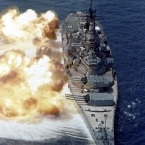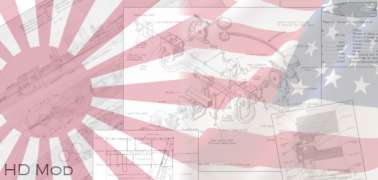JuanG
Posts: 906
Joined: 12/28/2008
Status: offline

|
quote:
ORIGINAL: Historiker
quote:
The reasoning regarding the RN is that, yes, they do have a faster battleline, but the IJN expects the RN to deploy mainly the older QE and R classes to the far east, along with one or two of the old battlecruisers.
I doubt that the IJN would do such a gamble and consider one of their potential main enemys will just send its old ships. IMO, Japan would never accept a smaller battleline that doesn't even have the initiative!
How long will it delay the 6 ships if they are faster? half a year each? Is that realistic? You already expect the Echizens and the Yamatos to be built parallel, right? So the Sagamis mid 1940 and the Yamatos early 1942?
You might use a trick with the Echizens: Since Hiraga shortly after WW1, the belt armour of the Ships was used as hull itself and "just welded" onto the basic structure. In theory, one may design the belt very weak to save weight and prepare ths ship from the beginning to recieve additional armour as soon as the Treatys allow it. For stability, it might recieve huge concrete pieces under the keel and the "real" armour may already lay ready in the navy yards. This was never done but must be theoretically possible and would consequently allow a much bigger ship to be built without violating the treaty as the fitting with the intended armour would just take as much time as it takes to replace the armour.
I doubt there won't show up someone who says this is stupid, but understand it as animation. I came to that idea reading Wilhelm Treue's "Die Deutsche Marinerüstung" where he described that Germany built subs despite the Versailles treaty. They were dismantled in the navy facitlitys and prepared for a fast assembly in case of war.
If Japan is willed to do such a thing, it can find a way to do it for sure. Whether this is too far away from reality or not is your choice!  I'm no naval engineer, but from my understanding, with additional weight under the ship, this should be really possible to do! I'm no naval engineer, but from my understanding, with additional weight under the ship, this should be really possible to do!
Doh, I just realized I missed this entire post. I'm so sorry!
One pair of building slips;
Echizen - Laid down late 1936 - Launched early 1939 - Comissioned early 1940 (~28 months to launch)
Hiryu - Laid down mid 1939 - Launched mid 1941 - Comissioned mid 1942 (~23 months to launch)
The other two big slips;
Soryu - Laid down late 1936 - Launched early 1939 - Comissioned early 1941 (~24 months to launch)
Yamato - Laid down early 1939 - Launched early 1941 - Comissioned late 1941 (~26 months to launch)
In comparison, some historic ships;
Yamato ~ 33 months to launch
Musashi ~ 32 months to launch
Shokaku ~ 26 months to launch
Zuikaku ~ 18 months to launch (!!!)
Iowa ~ 26 months to launch
So I think these are pretty reasonable. What I mean with "switch Yamato and Hiryu" is that Hiryu would be build immediately after Soryu on the same slips, thus meaning they'd probably be in comission late 1941. It also sort of makes sense for the yard that just did two of them to get orders for the repeat builds....hmm.
I reckon that increasing their speed to 30 knots would probably mean a displacement around 64,000tons, some 8,000tons heavier than right now. This means they would probably add, around 4-6 months of build time. And a lot of machinery.
Regarding the RN, I really dont know...On one hand though, the RN battleline is only using 15in guns, while most of the IJN is 16in gunned. This could lead to a sense of superiority over their 'lightly armed' battleships, enough to let them have their 3 knot advantage.
The idea of 'add it later' armour is an interesting concept, and one the IJN sort of did with Hiei during her conversion to a training ship, where her armour and guns were reduced and added back on later. In this AU both Kongo and Hiei have this done, Hiei as a training ship and Kongo as a target.
The current Echizen design looks roughly like this;
860ft x 120ft x 34ft
56,500t standard
63,700t full load
4 x 3 x 16in/50 - two fore, two aft, superfiring
2 x 3 x 5.5in/60 - two on ends, superfiring as in Yamato
4 x 2 x 5.5in/60 - two per side
8 x 2 x 5in/40 - four per side, elevated as in Yamato
Belt - 14in (355mm)
Deck - 7.5in (190mm)
Turrets - 20.5in (520mm)
Tower - 18.1in (460mm)
Speed - 27.3 knots @ 120,000hp
Range - 11,500nm @ 15 knots using 7,150tons of fuel
A 30 knot design would look like this;
980ft x 115ft x 35ft
63,100t standard
71,000t full load
4 x 3 x 16in/50 - two fore, two aft, superfiring
2 x 3 x 5.5in/60 - two on ends, superfiring as in Yamato
4 x 2 x 5.5in/60 - two per side
8 x 2 x 5in/40 - four per side, elevated as in Yamato
Belt - 14in (355mm)
Deck - 7.5in (190mm)
Turrets - 20.5in (520mm)
Tower - 18.1in (460mm)
Speed - 30.3 knots @ 175,000hp
Range - 11,500nm @ 15 knots using 7,150tons of fuel
So yes, my estimate of it being comparable in size to the historical Yamato is correct.
< Message edited by JuanG -- 8/2/2009 3:03:35 PM >
_____________________________
|
 Printable Version
Printable Version


















 New Messages
New Messages No New Messages
No New Messages Hot Topic w/ New Messages
Hot Topic w/ New Messages Hot Topic w/o New Messages
Hot Topic w/o New Messages Locked w/ New Messages
Locked w/ New Messages Locked w/o New Messages
Locked w/o New Messages Post New Thread
Post New Thread